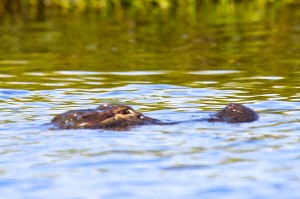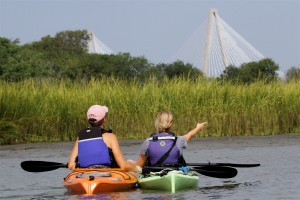This past Sunday I had the pleasure of helping Don guide a group of people to Sharks Tooth Island on the Cape Fear River where we hunted for prehistoric sharks teeth and fossils. Around mid-morning everyone had found their fair share of sharks teeth and fossilized shells on the island and were ready to get back on the water to do some more paddling. It was at this time that Don and I had noticed a fairly large container ship easing its way up the river towards the port, so we decided to stay on the island and let the ship pass by before returning to our kayaks and continuing the adventure. We chose to stay on the island because these container ships are known for having big wakes, especially while traveling in a river such as the Cape Fear. The areas where this is most prominently noticed are in shallow water. Because just like any wave, the wake from these ships doesn’t start to break until it finds shallow water. This is especially important to know while paddling because when the wake from those ships hit shallow water and start to break, it can provide an authentic whitewater experience here on the coast. And if you find yourself paddling through shallow water when this happens, you will most likely get flipped out of your boat.
So as the ship passed by, we gathered our group on the side of Sharks Tooth Island that faces Kegg Island, watching the wake from the container ship crash into the shallow water around the island. After we had watched the wake stop crashing in the shallow water between the islands we then headed back to our kayaks to continue our adventure. It was at this time, we noticed a fisherman who was fishing on the opposite side of Sharks Tooth Island in a small john boat had been capsized by the wake. From the position we were at, we noticed the man didn’t have a PFD in sight, his boat was completely swamped, and he was having trouble swimming. So, Don and I immediately began our rescue procedures by jumping in our boats and getting to the man as quickly as possible to save him from drowning. Once we were able to get the man safely to shore, we then recovered his gear that was floating away and fortunately we had additional help to recover his boat and paddle as well.
This situation goes to show that if you are out paddling, or on any outdoor adventure, without a trained professional, that being aware of your surroundings can help you better manage for any possible risks and it could possibly save your life. It is also a great example of why you should always wear a life jacket while paddling on the water. Because if you paddle enough, it’s not a matter of “if” but a matter of when you are going to fall out of your boat and go for a swim.
Don & Diane Harty own Mahanaim Adventures. They specialize in helping families and groups to have “Positive & Memorable” outdoor adventures. Whether these are wildlife view adventure, camping adventure or a simple kayaking adventure. They provide kayaking adventures on Town Creek, Cape Fear River, Fort Fisher Basin, Masonboro Island, Black River, Holly Shelter Creek and Moores Creek. Contact them at www.mahanaimadventures.com for more information about all of their adventures.
This blog was written by Mike Manning. I am Mahanaim Adventures new intern for the summer of 2018. I am a Park and Recreation Management student at East Carolina University, Go Pirates! I love the outdoors and have a strong passion for kayaking. This coming summer I will be writing a blog similar to this every other week to let everyone know about the awesome adventures we will have on the water this summer.

